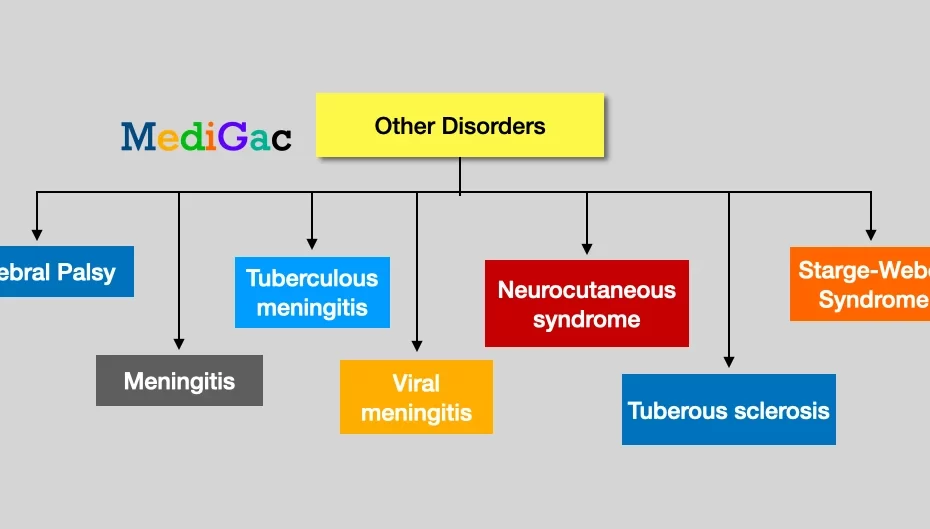We have discussed total seven other important diseases of CNS. They are as follows :
- Cerebral palsy
- Meningitis
- Tuberculous meningitis
- Viral meningitis
- Neurocutaneous syndrome
- Starge Weber syndrome
1. Cerebral palsy :
Cerebral palsy (CP) is a collection of conditions that impact a person’s ability to move, balance, and maintain posture. The most prevalent motor disability in children is cerebral palsy. Cerebral refers to something that has to do with the brain. Palsy refers to muscle weakness or difficulty using muscles.
Presenting clinical features :
- Muscle tone imbalances, such as being overly stiff or too floppy.
- Muscles that are stiff but have normal responses (rigidity)
- Instability of balance and coordination of muscles (ataxia)
- Tremors are uncontrollable motions.
- Exaggerated reflexes and stiff muscles (spasticity)
- Writhing, slow movements.
2. Meningitis :
Meningitis is a condition in which the protective membranes that surround the brain and spinal cord become inflamed (swell). The swelling is usually caused by a bacterial or viral infection of the fluid around the brain and spinal cord.
Presenting clinical features :
- Vomiting and/or Fever
- Skin that is pale or mottled
- Headache that is severe
- Breathing quickly/not at all
- Pain in the limbs, joints, or muscles
- Shivering/cold hands and feet
3. Tuberculous meningitis :
Tuberculous Meningitis (TBM) is a type of meningitis caused by Mycobacterium tuberculosis, which causes inflammation of the membranes (meninges) around the brain or spinal cord.
Presenting clinical features :
- Fever
- Stiff neck
- vomiting are all possible side effects
- Headaches
- Irritability may proceed to confusion, drowsiness, and stupor in older children and adults, possibly leading to coma
4. Viral meningitis :
When viruses cause viral meningitis, the tissue layers that cover the brain and spinal cord (meninges) and the fluid-filled area between the meninges (subarachnoid space) become inflamed.
Presenting clinical features :
- Fever
- Neck stiffness
- Nausea
- Headache
- Irritability
- Vomiting
- Photophobia is a fear of photographs (eyes being more sensitive to light)
- Sleepiness or difficulty waking up from a nap
5. Neurocutaneous syndrome :
The brain, spinal cord, organs, skin, and bones are all affected by neurocutaneous syndromes. The disorders are chronic illnesses that can lead to tumour growth in certain regions. Other issues that they can cause include hearing loss, seizures, and developmental issues.
Presenting clinical features :
- Migraines
- Convulsions
- Hearing loss
- Scoliosis, and facial discomfort or numbness are all symptoms that might occur.
6. Tuberous sclerosis :
Tuberous sclerosis (TSC) is a rare multi-system hereditary disorder that causes non-cancerous (benign) tumours to grow in the brain and other important organs such the kidneys, heart, eyes, lungs, and skin.
Presenting clinical features :
- Abnormalities of the skin
- Cognitive impairments.
- Lung issues.
- Seizures.
- Problems with behaviour.
- Problems with the kidneys.
- Heart problems.
- Anomalies of the eyes
7. Starge-weber syndrome :
Sturge-Weber syndrome (SWS) is an uncommon condition marked by the presence of a port-wine birthmark on the face, as well as neurological and visual problems such as glaucoma.
Presenting clinical features :
- Seizures.
- Headache.
- Thyroid dysfunction (hypothyroidism)
- On one side, there is paralysis or weakness.
- Learning impairments are a type of learning disability.
- Glaucoma is a disease that affects the eyes (very high fluid pressure in the eye)
- Stain from port wine (more common on the upper face and eye-lid than the rest of the body)
